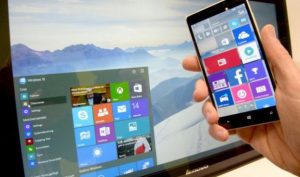 It’s almost a year since Microsoft launched Windows 10 – which means two things.
It’s almost a year since Microsoft launched Windows 10 – which means two things.
Firstly, there’s an Anniversary Update on the way. With that, some enhancements to Cortana and the web browser, Edge – as well as an attempt to reinvent the stylus.
Secondly, there’s only one month left before the Windows 10 free upgrade offer ends. After that date, it will cost $119 (£89).
In a phone call with the BBC, head of Windows Yusuf Mehdi said more than 350 million devices were now being powered by Windows 10.
It has undoubtedly been a strong first year. Aside from the backlash from some users who felt Windows 10 was being forced upon them, the operating system is generally regarded as a welcome return to form for the company that still powers the vast majority of the world’s desktop and laptop computers.
“Customer satisfaction is at an all time high,” Mr Mehdi told me.
“We’ve had over 135 billion hours of usage since the launch.”
He’ll be hoping to convince many more users to take advantage of the free update before the deadline hits.
The lofty goal, set out by Microsoft 12 months ago, is to achieve more than a billion devices running Windows 10 within the next two years.
Satya’s gamble
When Windows 10 was launched, the big news was that it would be made available as a free upgrade for Windows 7 or 8 users, on any device with hardware capable of running it.
At a time when Microsoft was well and truly left behind by the smartphone boom, the Windows 10 strategy, put into action by the then-new chief executive Satya Nadella, was certainly a bold move.
A year on, we’re starting to be able to look at whether Mr Nadella made the right call.
“Despite progress towards the one billion goal, Microsoft faces the reality that consumer engagement is far greater on mobile than PC or tablet and this continues to be a significant disadvantage,” said Geoff Blaber from CCS Insight.
Mr Blaber suggests Microsoft is already well down a path that has it placed as a company now almost entirely focused on businesses rather than general consumers.
“Over 300 million devices is solid progress for Windows 10 and Microsoft has successfully turned the tide of public opinion in the wake of Windows 8,” he said.
“Nonetheless, Microsoft’s future is moving towards a far greater focus on enterprise than consumer.
“Microsoft is successfully transforming Windows into a service and creating the platform for a future that’s likely to be more about enterprise services, cloud and artificial intelligence than consumer computing.”
When I interviewed Mr Nadella last year, I put it to him that people had historicallyonly used Windows begrudgingly. It was the operating system at school, at work, and on the only computer you could afford.
It was the only comment that had the usually ice-cool Mr Nadella a little riled.
With Windows 10, he insisted, people would come to not just need Windows, but want it. Perhaps even love it. The usage statistics show Microsoft has done well in getting people on Windows 10.
But to what end? The company is still well behind when it comes to powering devices that live in our pockets, rather than on our desks.
Tempting updates
The Anniversary Update, which will be released on 2 August, includes a hefty number of new features.
As has been a big trend across the tech industry this entire year, Microsoft’s voice-activated assistant Cortana is becoming an even more integral part of the operating system.
On Windows 10-powered devices, Cortana will soon sit above the lock screen. That means you won’t have to sign in to your device in order to interact with Cortana. It’s a nice time saver – although the idea is already in place on Android and iOS.
Also in the time-saving pile is Windows Ink. The company has shared some infoon Windows Ink already, but the Anniversary Update will be when it makes its full public debut.
“In this release you’re going to see the pen become a first-class method of input,” promised Mr Mehdi, explaining how the pen – a stylus, in other words – could now be used to scribble notes quickly on to the screen.
Like Cortana, much of Windows Ink’s appeal will be that you don’t need to unlock the device in order to use it. You just click the pen and begin writing on the screen.
Also in the update: more uses for Windows Hello. For a while, Hello has been able to log you into a Windows 10 device just by recognising your face (or fingerprint).
Now Microsoft hopes to expand that capability to websites. Mr Mehdi envisions a time when you can sign in to your favourite websites using your face rather than a password – an obvious improvement at a time when security experts are questioning the long-term suitability of passwords.
The function works within the Edge browser. Web developers only have to add a small amount of code, Mr Mehdi says, in order to enable Hello log-ins on their site.
Don’t expect many of them just yet, mind. Microsoft couldn’t give me any examples of websites that were planning to incorporate log-ins via Hello.
The company pointed out that Windows 10 apps made by iHeartRadio and Dropbox already supported the function – though that had been the case for months, and did not include those firms’ websites. A long way to go on that idea, then.
You could say this example alone underlines Microsoft’s challenge at the moment.
It isn’t having any trouble coming up with new and interesting ideas. But where Microsoft’s Windows team still appears to struggle is in getting others – be they users or developers – to be as excited about Windows 10 as they are.
 Komashisha
Komashisha



